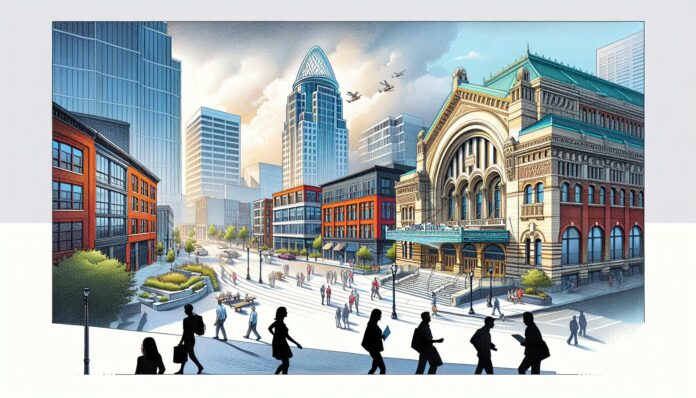Cincinnati’s always had its charm, but lately, there’s something electric in the air. It’s not just the chili or the river views getting folks excited. It’s the buzz around the city’s up-and-coming neighborhoods. Places once overlooked are now bursting with new life, making them the talk of the town.
I’ve spent some time wandering these streets, and I’m here to share the scoop. From cozy coffee shops to vibrant street art, each neighborhood has its own unique flavor. And let me tell you, there’s a lot to love. Whether you’re a local looking for new spots to explore or planning a visit, these areas are where you’ll want to be.
So, let’s dive in and discover what makes these Cincinnati neighborhoods the places to watch. Trust me, you won’t want to miss out on the excitement brewing in these corners of the city.
Over-the-Rhine: A Historic Revival
As I wandered through the historic streets of Over-the-Rhine (OTR), I couldn’t help but be amazed at the transformation this Cincinnati neighborhood has undergone. Once a neglected area, OTR is now a buzzing hub of culture and activity, breathing new life into its historic buildings. It’s a testament to the city’s commitment to revitalizing its urban core, blending the old with the new in an inspiring display of urban renewal.
At the heart of OTR’s revival is its incredible architecture. The area boasts the largest collection of Italianate architecture in the country, and it’s been meticulously preserved and restored. Walking down Vine Street, I’m greeted by ornate facades that house everything from trendy boutiques to craft breweries, each adding a unique flavor to the neighborhood’s vibrant tapestry.
But it’s not just the architecture that draws me to OTR; it’s the community’s spirit. The neighborhood is a melting pot of cultures, attracting a diverse mix of residents and visitors. Local art and music thrive here, with street murals and galleries dotting the landscape, and live music venues offering everything from jazz to indie rock.
Foodies Rejoice
OTR is a paradise for food lovers. The neighborhood’s culinary scene is booming, with an impressive array of dining options. From quaint coffee shops where baristas know your name to fine dining restaurants pushing the boundaries of cuisine, there’s something for every palate. I’ve indulged in mouthwatering dishes that span the globe, including authentic Neapolitan pizza, contemporary American fare, and innovative fusion cuisine. The Findlay Market, Ohio’s oldest continuously operated public market, is a focal point for food enthusiasts, offering fresh, locally sourced produce and goods.
A Hub for Creativity
The creative energy in OTR is palpable. Artisan shops and studios line the streets, showcasing the talent and creativity of local artists and makers. Here, I’ve discovered handcrafted jewelry, unique home decor, and artwork that speaks to the soul. Events like the Final Friday gallery hop bring the community together to celebrate art, culture, and creativity, turning the neighborhood into a festive gathering place.
Walnut Hills: Culture and Creativity Collide
Walnut Hills is another Cincinnati neighborhood experiencing a remarkable renaissance. I’ve watched this area evolve, blending cultural heritage with contemporary creativity, making it an exciting place to explore. Here, the streets are alive, not just with history, but with a palpable sense of renewal that beckons locals and visitors alike.
At the heart of this neighborhood’s transformation is the Eden Park, a sprawling green space that’s not just for joggers and picnickers. It’s where art meets nature. The Cincinnati Art Museum and the Krohn Conservatory are nestled within its bounds, offering a cultural feast for the eyes and the soul. I love spending my afternoons here, soaking in the diverse exhibitions and the exotic flora.
The culinary scene in Walnut Hills is another testament to its vibrant culture. Diverse eateries offer everything from soul food to contemporary American cuisine, reflecting the neighborhood’s eclectic community. I’ve had some of my most memorable meals here, in places where the food tells a story of tradition and innovation.
What truly sets Walnut Hills apart, however, is its celebration of creativity. The neighborhood is dotted with independent bookstores, coffee shops, and art studios, each with their own unique flair. I’m always amazed at the local talent showcased during the monthly art walks, where residents and visitors come together to celebrate the neighborhood’s artistic spirit.
The residential streets of Walnut Hills are a mix of the old and the new, with historic homes undergoing restoration next to modern apartments. This blend of architectural styles mirrors the neighborhood’s overall character – respectful of its past while firmly looking forward.
I’ve seen firsthand how Walnut Hills has become a beacon for those seeking a community that values diversity, creativity, and cultural richness. The ongoing investments in public spaces, housing, and local businesses are ensuring that this neighborhood isn’t just flourishing now, but is set for a bright future.
Northside: Quirky Charm and Community Spirit
When I ventured into Northside, the neighborhood’s quirky charm and undeniable community spirit were palpable from the get-go. It’s a place where diversity and creativity aren’t just welcomed; they’re celebrated. I found myself walking down streets lined with vibrant murals and bustling small businesses, each telling its own story of the neighborhood’s rich, eclectic identity.
One thing that stands out about Northside is its fiercely independent nature. Locally-owned shops, cafes, and restaurants dot the landscape, all contributing to the neighborhood’s unique vibe. I made it a point to visit Blue Rock Street, renowned for its eclectic array of shops. From vintage clothing stores to independent bookshops, each establishment was a testament to the community’s support for local entrepreneurship and creativity.
The dining scene in Northside reflects its diversity. I was thrilled by the range of cuisines on offer, from authentic Mexican dishes at Taqueria Mercado to savory vegan options at Melt Eclectic Cafe. It was clear that no matter your dietary preferences, Northside has something special to offer.
But what truly sealed my love for Northside was its community spirit. The neighborhood hosts various events throughout the year that bring residents and visitors together, creating a sense of unity and belonging. The Northside Fourth of July Parade is a perfect example, a celebration that showcases the neighborhood’s quirky character and inclusive ethos. It’s a day when everyone, from families to local artisans, comes together to celebrate their community.
Moreover, green spaces like Hoffner Park are central to life in Northside. These areas serve as communal gathering spots, where people come to relax, picnic, and attend various community-organized events. The park’s serene ambiance offers a perfect escape from the urban rush, emphasizing the neighborhood’s balanced lifestyle.
Investments in infrastructure and community programs continue to make Northside an even more inviting place to live and visit. Efforts to maintain the historic architecture while introducing modern amenities reflect the neighborhood’s commitment to growth without losing sight of its roots.
East Price Hill: Scenic Views and Hidden Gems
As I ventured into the heart of Cincinnati for this series on up-and-coming neighborhoods, I couldn’t help but be drawn to the scenic charm of East Price Hill. This neighborhood, perched on the city’s west side, offers breathtaking views of the downtown skyline, especially as the sun sets. It’s one of those places that might not make it onto every tourist’s map, but it’s definitely worth a visit for anyone looking to discover Cincinnati’s hidden gems.
One of the first things I noticed about East Price Hill was its vibrant community spirit. The residents are incredibly welcoming and have a tight-knit sense that’s palpable as you walk its streets. It’s this sense of community that seems to drive the neighborhood’s revitalization efforts, with several local initiatives aimed at bringing new life to its historic buildings and green spaces.
Local businesses here have a character all of their own. From quaint cafes to family-owned restaurants offering a slice of local cuisine, the dining scene is as diverse as it’s charming. What stands out is how these establishments make you feel like you’re part of the community, even if you’re just passing through.
But it’s not just about the food or the views. East Price Hill is home to some truly unique attractions. One such place is the Warsaw Avenue Firehouse. Converted into a community space, it’s become a hub for local artists and creatives. I was amazed at the range of activities and events on offer, from art classes to live music nights.
Moreover, exploring the neighborhood, you can’t help but admire the beautifully restored homes that line the streets. This architectural revival adds another layer to the neighborhood’s charm, promising potential homebuyers not just a house but a piece of Cincinnati’s rich history.
For those who appreciate nature, the lush parks and green spaces are a testament to the neighborhood’s commitment to providing a balanced lifestyle. I spent a lovely afternoon in Dunham Recreation Complex, which offers everything from scenic trails to sports facilities. It’s a perfect spot for an escape within the city.
Investment in East Price Hill is on the rise, with efforts focused not just on beautifying the area but also on empowering its residents. This approach has begun to attract a diverse crowd, from young professionals to artists, all looking to be part of a community that celebrates its heritage while looking forward to a bright future.
West End: Urban Renewal and Cultural Hotspots
When I first set foot in the West End of Cincinnati, I was immediately struck by its vibrancy and the palpable sense of renewal that seems to hang in the air. This is a neighborhood in the midst of transformation, where the energy of urban renewal is almost visible on every street corner. It’s not just the new buildings and the renovations of historic structures that catch the eye; it’s the way these changes are melding with the area’s rich cultural history to create something genuinely unique.
One of the most compelling aspects of the West End is its diverse cultural hotspots. The neighborhood is home to Music Hall, a stunning piece from Cincinnati’s history that continues to be the centerpiece of the West End’s cultural life. This iconic venue hosts everything from classical music to contemporary concerts, making it a must-visit for anyone exploring Cincinnati’s cultural landscape. Furthermore, just a stone’s throw away, the Cincinnati Ballet offers breathtaking performances, highlighting the neighborhood’s commitment to the arts.
But it’s not just about the established venues. The West End is teeming with emerging artists and grassroots initiatives that are transforming the neighborhood into a vibrant arts district. From street murals that tell the stories of the community to pop-up galleries showcasing local talent, creativity is the lifeblood that courses through the streets here.
The focus on renewal extends to the community’s approach to business too. A wave of new restaurants, cafes, and boutique stores has swept through the neighborhood, each bringing its own unique flavor to the West End. These businesses are more than just places to eat or shop; they’re integral parts of the community, often hosting events that bring residents and visitors together.
One cannot talk about the West End without mentioning its ongoing urban development projects. These initiatives are carefully designed to enhance the neighborhood’s appeal while preserving its historical essence. The rejuvenation of Union Terminal, for instance, is not just an investment in infrastructure but a commitment to honoring the legacy of the West End. Such projects, coupled with the neighborhood’s growing green spaces, are making the West End a model for balancing urban living with environmental sustainability.
In my travels through Cincinnati, I’ve found that the West End encapsulates the city’s spirit of innovation and community. Here, past and future coalesce in a dynamic tableau, offering a glimpse into the potential of urban neighborhoods across the nation.
Conclusion
Exploring the West End has been an eye-opening journey for me. It’s incredible to see how this neighborhood has embraced change while staying true to its roots. The blend of history and innovation here is a testament to Cincinnati’s vibrant community. Whether it’s the arts, architecture, or local initiatives, there’s a sense of pride and progress that’s hard to miss. I’m excited to see how the West End continues to evolve and inspire other neighborhoods across the country. It’s clear that this corner of Cincinnati is not just up-and-coming; it’s already a shining example of urban renewal done right.



![Top Kid-Friendly Eats & Fun in [Specific Neighborhood] Cincinnati](https://queencitybuzz.com/wp-content/uploads/2024/03/80M4yIoZGkTTPpLZlG9GQ-218x150.jpg)













